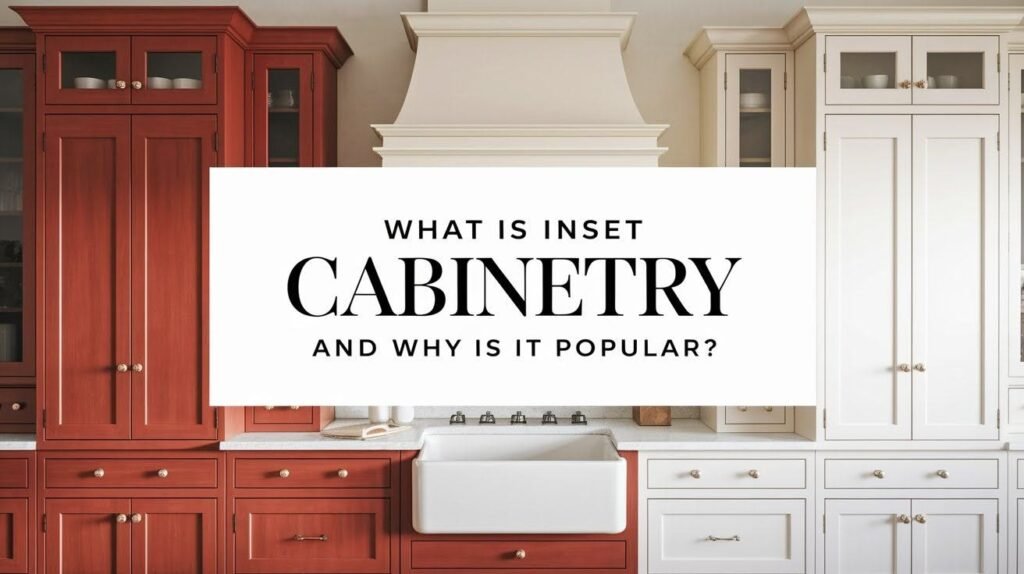When planning a kitchen or bathroom renovation, selecting the right cabinetry style significantly impacts both functionality and aesthetics.
Among the various options available, inset cabinetry stands out as a timeless design choice that has experienced a remarkable resurgence in recent years.
This classic construction method, where cabinet doors and drawers sit flush within the frame, offers a clean, refined appearance that appeals to modern homeowners seeking both quality and style.
In this post, we’ll examine what inset cabinetry entails, trace its historical roots, and analyze the advantages and disadvantages of this construction method.
We’ll also investigate why this traditional approach has regained popularity among homeowners and designers who value craftsmanship and sophisticated design in their living spaces.
What Is Inset Cabinetry?
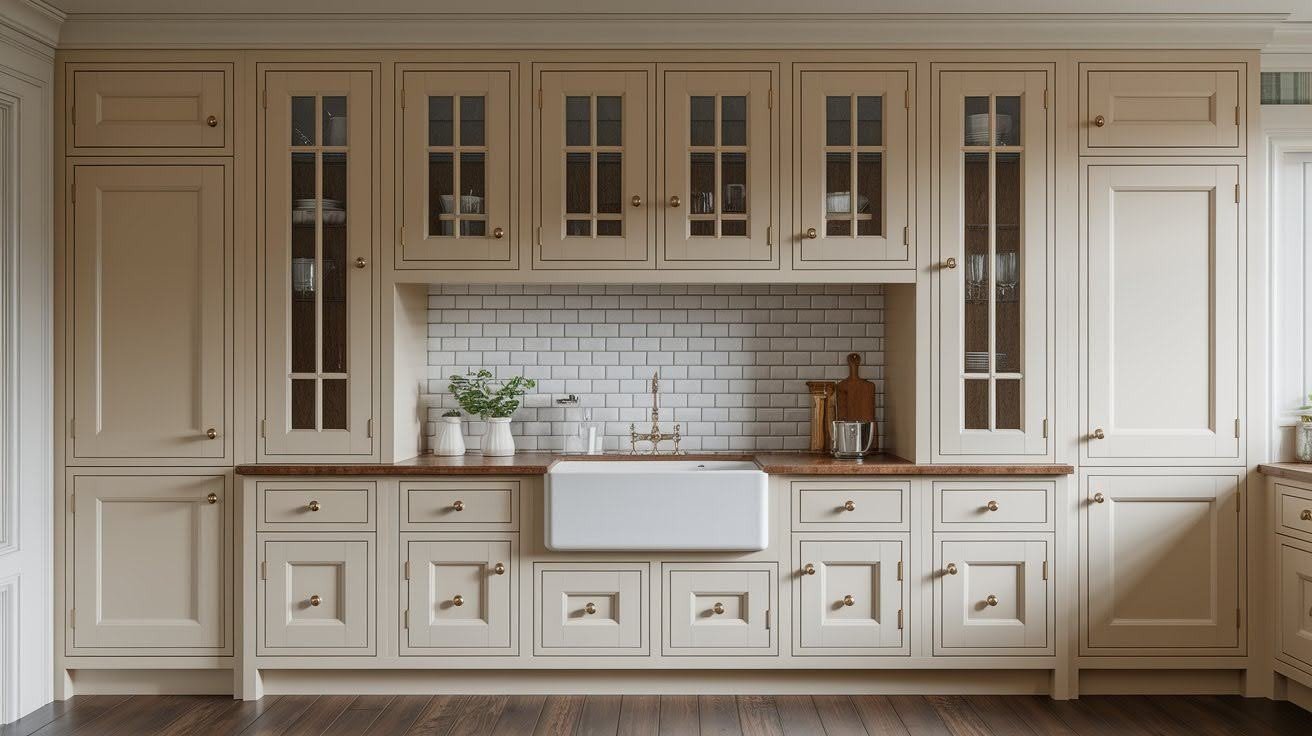
This section explains the fundamental characteristics of inset cabinetry design and construction. It covers the technical definition of how inset cabinets differ from standard overlay styles, along with the historical background that shaped this traditional woodworking approach.
Definition
Inset cabinetry represents a construction method where cabinet doors and drawers are positioned within the cabinet frame rather than on top of it.
Unlike overlay styles, where doors and drawers cover the face frame, inset components sit flush with the front of the cabinet structure.
This creates a smooth, continuous surface where the door and drawer faces align perfectly with the cabinet frame, producing a clean, integrated appearance.
The precision required for this installation method demands exact measurements and skilled craftsmanship, as each door and drawer must fit precisely within its designated opening.
This attention to detail results in minimal gaps between components and a seamless finish that showcases superior woodworking skills.
Historical Inspiration
Inset cabinetry traces its origins to the Georgian and Victorian periods, when furniture makers employed similar techniques for creating fine furniture pieces.
During these eras, cabinetmakers applied the same meticulous construction methods used for armoires, dressers, and other furniture to kitchen and storage cabinetry.
This approach emphasized furniture-style craftsmanship, where each piece was built with precision and attention to detail, reflecting the quality standards expected in well-appointed homes of the time.
Why Is Inset Cabinetry So Popular?
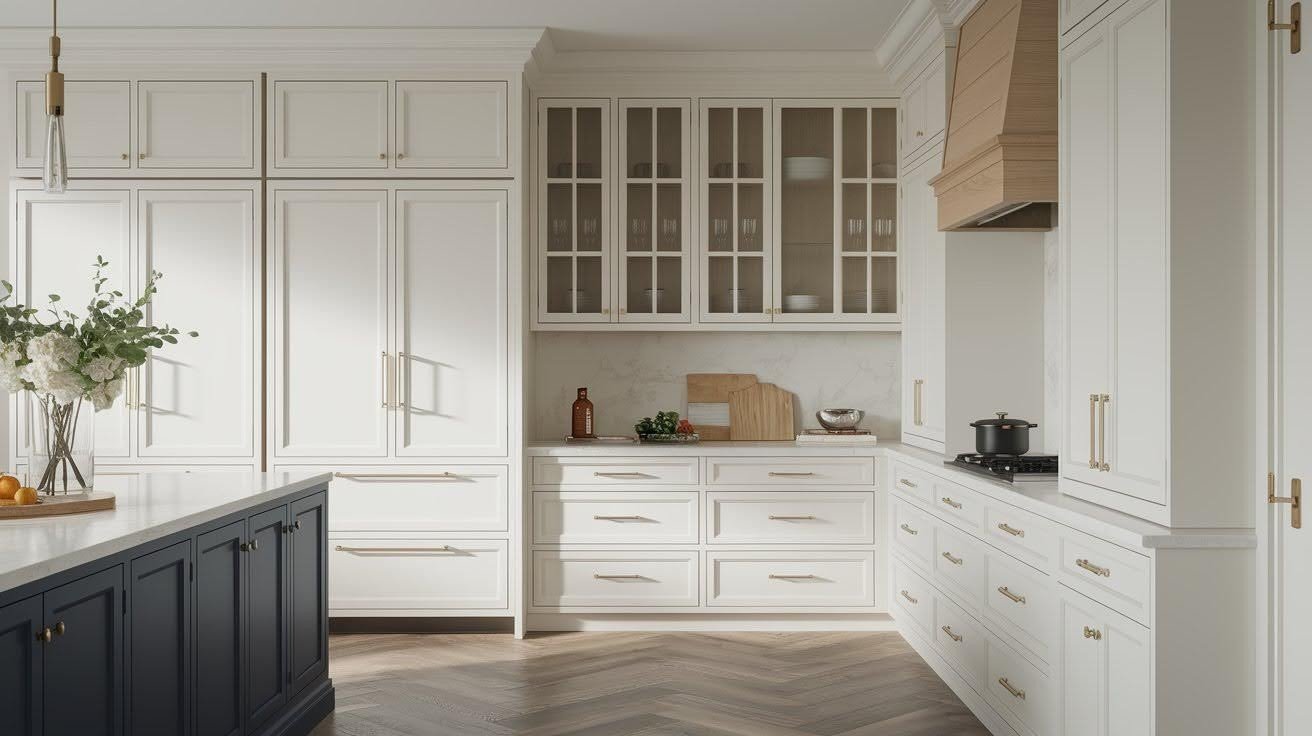
This section examines the key factors driving the current popularity of inset cabinetry, from its aesthetic appeal to practical benefits that make it an attractive choice for homeowners and designers.
1. Timeless Look
Inset cabinetry creates an appearance that closely mimics fine furniture, offering clean lines and precise construction that stands the test of time.
The flush alignment of doors and drawers with the cabinet frame produces a refined, sophisticated appearance that works well in both traditional and transitional interior designs.
This versatility allows homeowners to achieve a classic look that won’t feel outdated as design trends change.
2. Customization Options
Beaded vs. Non-Beaded Insets
- Beaded insets feature decorative trim around door and drawer openings, creating a detailed, classic appearance
- Non-beaded (flush) insets offer a sleek, minimalist aesthetic with completely smooth surfaces
The style accommodates a wide range of paints, stains, and finishes, allowing homeowners to match their specific color preferences and design schemes.
Additional embellishments and moldings provide further personalization opportunities, enabling each installation to reflect individual taste and complement existing décor.
3. High-Quality Craftsmanship
The construction of inset cabinetry requires skilled joinery and precise measurements, making it a marker of high-end, custom-built cabinetry. ‘
This level of craftsmanship appeals to homeowners who value quality construction and attention to detail in their home improvements.
4. Enhanced Durability
Flush doors reduce the likelihood of nicks and wear that can occur with protruding overlay styles. This durability makes inset cabinetry particularly suitable for kitchens, bathrooms, and built-ins in high-traffic areas where cabinets face frequent use.
5. Increased Resale Appeal
Inset cabinetry is perceived as premium cabinetry, potentially adding value to a home, especially in upscale markets where buyers appreciate quality craftsmanship and attention to detail.
Inset Cabinets vs. Overlay Cabinets
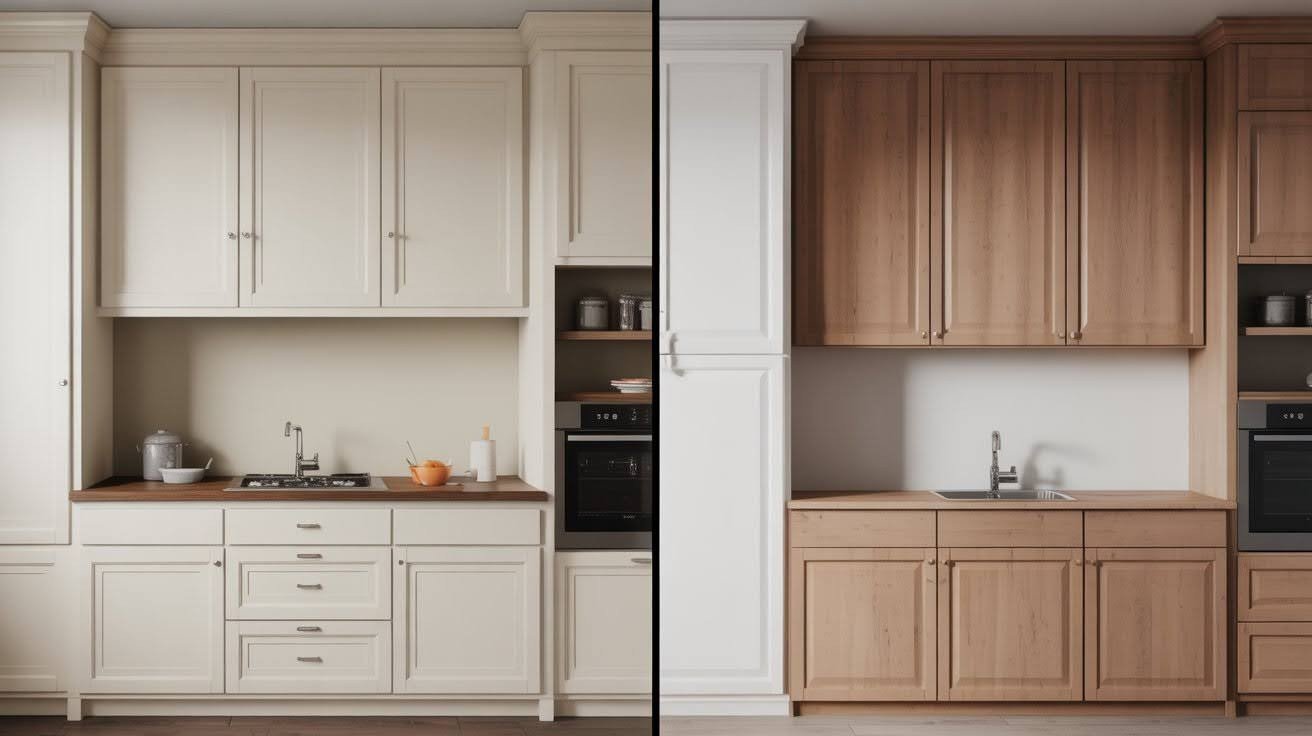
Understanding the differences between inset and overlay cabinet construction helps homeowners make informed decisions about their cabinetry investments.
Overlay Cabinets
Overlay cabinets feature doors that sit over the cabinet frame, available in partial or full overlay configurations.
This construction method is easier to manufacture and install, as it allows for greater tolerance in measurements and adjustments during installation.
Overlay cabinets also maximize storage space since the doors don’t need to fit within frame openings, allowing for larger drawer boxes and interior storage areas.
Inset Cabinets
Inset cabinets feature flush doors positioned within frame openings, creating a seamless appearance where all components align perfectly.
This construction method requires significantly more precision during both manufacturing and installation, as each door and drawer must fit exactly within its designated opening.
The higher level of craftsmanship required typically makes inset cabinets more expensive than overlay alternatives, but many homeowners consider the investment worthwhile for the superior aesthetic and quality construction they provide.
The choice between these two styles often comes down to budget considerations, desired aesthetics, and the level of craftsmanship homeowners value in their cabinetry selection.
Comparison Table
|
Feature |
Inset Cabinets |
Overlay Cabinets |
|
Door Fit |
Sits inside the frame |
Sits over the frame |
|
Visual Style |
Traditional, refined |
Versatile, from classic to modern |
|
Hinges |
Visible or concealed |
Mostly concealed |
|
Cost |
Higher |
More budget-friendly |
|
Maintenance |
Requires adjustments over time |
Minimal |
This comparison table highlights the key differences between inset and overlay cabinet construction, helping homeowners understand the practical and aesthetic considerations for each option.
Things to Consider Before Choosing Inset Cabinets
Before committing to inset cabinetry, homeowners should carefully evaluate several important factors that may impact both the installation process and long-term satisfaction with their investment.
- Higher Price Point: Inset cabinets typically cost 15–30% more than overlay options due to the increased precision required during manufacturing and installation.
- Slightly Reduced Storage Space: The frame construction reduces the opening size for drawers and doors compared to overlay styles.
- Susceptible to Environmental Changes: Seasonal shifts in temperature and humidity may cause wood movement that leads to binding or alignment issues with doors and drawers.
- Requires Precise Installation: Cabinets must be perfectly square and level for proper door and drawer function.
This price difference reflects the additional labor time, specialized skills, and tighter tolerances needed to achieve the flush fit characteristic of inset construction.
This means interior storage capacity may be somewhat limited, as the frame takes up space that could otherwise accommodate larger drawer boxes or door openings.
Maintaining consistent indoor humidity levels is recommended to minimize these effects and ensure smooth operation throughout the year.
Minor misalignment during installation can significantly affect door performance, potentially causing gaps, binding, or uneven appearance that may require professional adjustments to correct.
Where to Use Inset Cabinetry
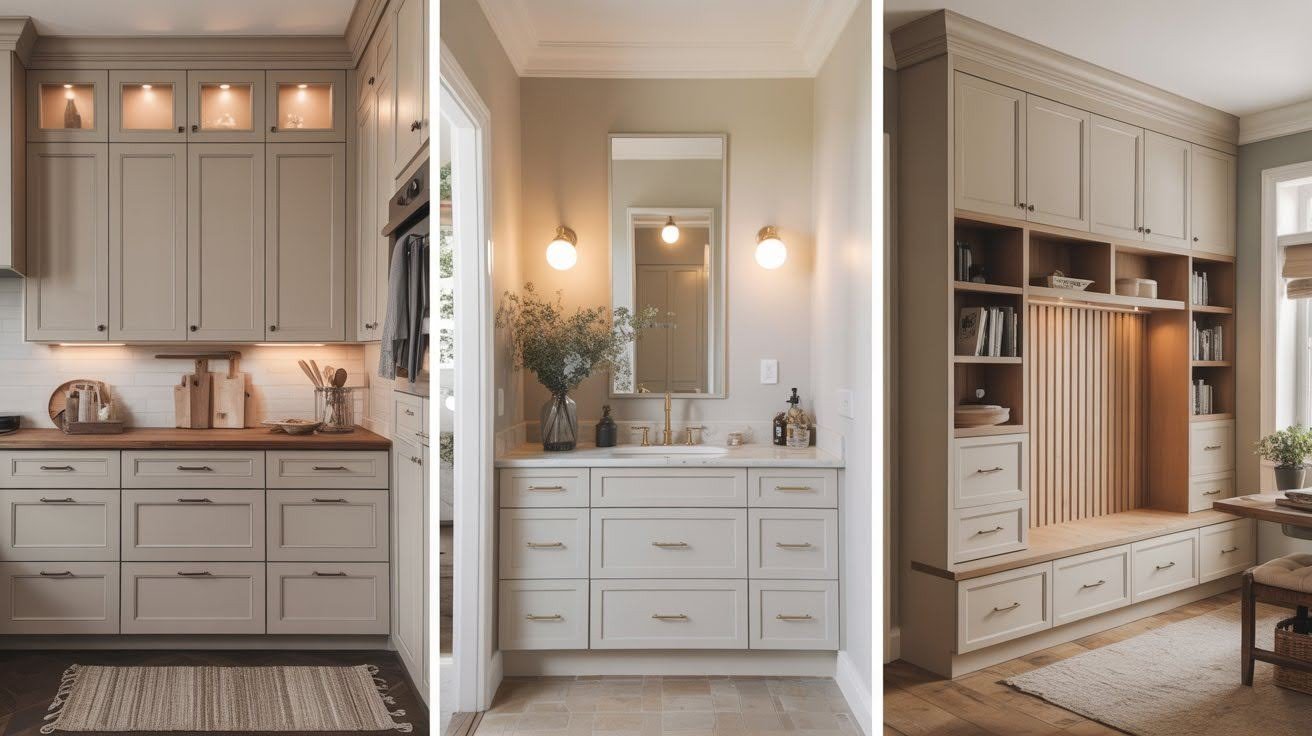
Inset cabinetry works exceptionally well in various spaces throughout the home, offering versatility while maintaining its characteristic refined appearance.
Kitchens
Inset cabinetry proves ideal for traditional or high-end transitional kitchen designs, where the flush construction creates a furniture-like appearance that complements both classic and contemporary elements.
The precise craftsmanship particularly suits spaces where homeowners want to showcase quality construction and attention to detail.
Bathrooms and Vanities
This cabinet style adds sophistication in smaller, personalized spaces where every detail matters.
The clean lines and flush surfaces work particularly well in bathroom environments, creating a spa-like atmosphere while providing functional storage solutions.
Built-In Units
Inset construction works beautifully in mudrooms, libraries, or living rooms where built-in storage needs to blend seamlessly with the room’s architecture.
The furniture-style appearance helps these functional elements feel like integral parts of the space rather than afterthoughts.
Conclusion
Inset cabinetry successfully blends old-world charm with modern luxury, creating a sophisticated option that appeals to discerning homeowners.
This construction method offers a refined alternative to standard cabinet styles, providing the clean lines and precise craftsmanship that distinguish quality installations from mass-produced options.
For homeowners who appreciate meticulous detail, superior quality, and heritage design elements, inset cabinetry represents an investment in both functionality and aesthetics.
While the higher cost and installation requirements may present considerations, the resulting timeless appearance and durable construction make this choice particularly appealing for those seeking to create spaces that reflect traditional craftsmanship values.
The enduring popularity of inset cabinetry demonstrates its ability to satisfy both practical storage needs and the desire for distinctive, well-crafted interior elements that enhance any home’s overall design quality.
Frequently Asked Questions
What is the main difference between inset and overlay cabinets?
Inset cabinets have doors and drawers that sit flush within the cabinet frame, while overlay cabinets have doors that sit on top of the frame. This creates a cleaner, more furniture-like appearance with inset construction.
Why does inset cabinetry cost more than overlay styles?
Inset cabinets require precise measurements and skilled craftsmanship to achieve the flush fit within frame openings. The additional labor time and expertise needed for proper installation increases the overall cost by 15-30%.
Do inset cabinets provide less storage space?
Yes, inset cabinets offer slightly less storage capacity because the frame takes up space that could otherwise accommodate larger drawer boxes. However, many homeowners find the aesthetic benefits outweigh this minor reduction in storage.
Are inset cabinets suitable for modern kitchen designs?
Absolutely, inset cabinets work well in both traditional and transitional kitchen designs. The clean lines and flush surfaces can complement modern aesthetics while providing the timeless appeal of quality craftsmanship.
What maintenance issues should I expect with inset cabinets?
Inset cabinets may require occasional adjustments due to seasonal wood movement caused by humidity changes. Maintaining consistent indoor humidity levels helps minimize binding or alignment issues with doors and drawers.

